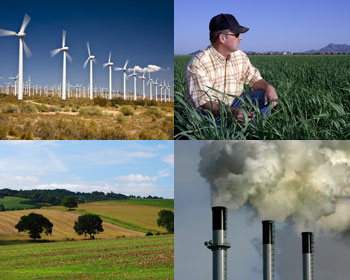A Publication of the
Applied Math and Science Education Repository

The AMSER Science Reader Monthly aims to provide educators with a useful package of information about a particular topic related to applied math and science by combining freely available articles from popular journals with curriculum, learning objects, and web sites from the AMSER portal. The AMSER Science Reader Monthly is free to use in the classroom and educators are encouraged to contact AMSER with suggestions for upcoming issues or comments and concerns at [email protected].
This month's AMSER Science Reader Monthly topic is carbon trading.
Carbon Trading: Environmental Godsend or Giant Shell Game?
Article by Jennifer Barone from Discover Magazine
Synopsis and resource annotations by Max Grinnell

In 1997, 182 nations signed the Kyoto Protocol, which effectively mandated the curbing of carbon emissions. Of course, one rather thorny matter was that the United States (a major contributor to carbon emissions), never ratified the Protocol. While many countries in the developed world were concerned about the effect of greenhouses gases on the environment, many countries in the developing world were also concerned about the effect that limiting carbon emissions would have on their economic future.
As Jennifer Barone reports in the December 2008 issue of Discover Magazine, part of the solution was to create a carbon market. Essentially, national governments set a cap limiting the total amount of greenhouse gases that industries can emit, and then those industries that wish to emit more (or less) can buy or sell these carbon emissions permits on the open market. This allows those in the developing world to purchase permits or offsets for their carbon emissions. Despite the fact that the U.S. did not ratify the Kyoto Protocol, the cap and trade system created as a result of the Protocol has its roots in the U.S Clean Air Act, which was remarkably successful in reducing the pollution that causes acid rain. However, as Barone reports, replicating this success internationally has not been as simple.
The article points out a number of key problems with the cap and trade system, including the differences in pollution regulation in the United States, Europe, and China. Barone explains that quantifying carbon emissions is often difficult and inaccurate. In the U.S., power plants are required to install instruments under the Clean Air Act and record their acid rain-causing emissions to the Environmental Protection Agency, while industries in Europe are not required to use any monitoring instrumentation. Thus, European industries are essentially responsible for their own carbon accounting. As Larry Lohmann, a researcher with the U.K.-based nonprofit the Corner House points out, "The margin of error for what's coming out of the stacks is way too wide to say whether emitters are in compliance with regulations. And when it's left up to the companies to do the reporting, they have a huge amount of discretion in saying how much they're emitting." Additional issues exist with regulating carbon emissions, including the validity and regulation of carbon offsets. Despite the complications with the cap and trade system and carbon offsets, Barone explains that most governments and researchers still believe that the shortcomings are not enough to stop making the laws governing greenhouse gases worth enacting.
Found below is a list of helpful resources that can help explain and enhance understanding of the comprehensive and complicated topics found within this article. The first link will help users better understand the concept of cap-and-trade programs with a working paper that discusses successful arrangements in reducing pollution in the United States. Both the second and third links provide a global perspective on pollution control by discussing how businesses and other institutions are attempting to cope with the effects of climate change. The fourth link leads to an activity that allows users to calculate how their daily lives impact the environment. This resource will help users not only calculate their carbon footprint, but it will also suggest helpful ways in reducing their impact. Moving on, the fifth link discusses the European Union's efforts to fight climate change and promote renewable energy resources and includes fact sheets and working documents by European Commission staff members. Finally, the last link will better explain how pollution affects atmospheric chemistry. The lesson examines indoor, point, and non-point pollution sources and allows users to find information about industrial polluters in their communities. Overall, these resources should provide greater scope and help contextualize the ideas and concepts found within in the featured work. The list provides links to resource records in the Applied Math and Science Education Repository (http://amser.org).



AMSER Science Reader Monthly is developed by Internet Scout at the University of Wisconsin-Madison in conjunction with the National Science Digital Library with funding from the National Science Foundation. If you have questions or suggestions please e-mail us at [email protected].